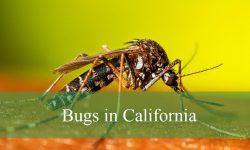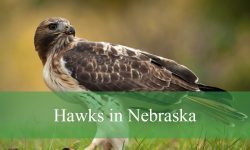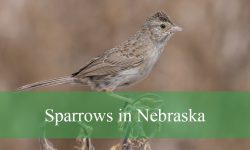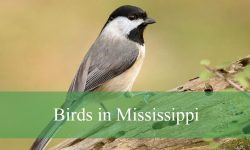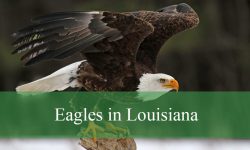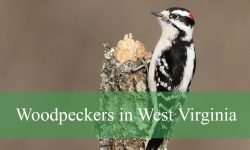North Carolina is home to a diverse avian population, including an array of woodpecker species. Among the 10 types of woodpeckers found in the state, the Hairy Woodpecker stands out with its distinctive black and white plumage. Its medium size, characteristic striped tail, and wings make it easily identifiable. The Downy Woodpecker, a smaller counterpart, is recognizable by its short, narrow beak and straight-backed posture. Another common sight is the Red-bellied Woodpecker, marked by its pale-red belly, red nape, and a striking red crest on males.
The Yellow-bellied Sapsucker, a winter visitor, showcases a pale-yellow belly and a penchant for sap-feeding. The elusive Ivory-billed Woodpecker, though rarely seen, was historically prominent in the southeastern U.S. Unfortunately, environmental changes have made sightings extremely rare. The Northern Flicker, with its colorful plumage and unique foraging habits, is a year-round resident often seen in open expanses.
The Ivory-billed Woodpecker, despite its historic significance, faces challenges due to habitat loss and is now considered endangered. Conservation efforts, led by organizations like the Audubon society, aim to protect these remarkable species in the ever-changing environment. As these woodpeckers navigate North Carolina’s diverse landscapes, they contribute to the state’s rich biodiversity, offering bird enthusiasts a fascinating glimpse into the avian world.
Below is a list of 10 woodpecker species found in North Carolina, along with a summary of how to identify them.
Different Types of Woodpeckers In NC
Hairy Woodpeckers
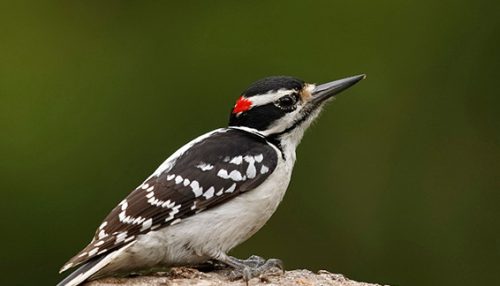
Characteristic |
Range |
|---|---|
Length |
7.1-10.2 inches |
Weight |
1.4-3.4 ounces |
Wingspan |
13-16.1 inches |
Habitat |
North Carolina |
Feeding Habits |
Nuts, mixed seeds, black oil sunflower seeds, bugs, spiders, bees, caterpillars, and other creatures |
Feather Pattern |
Black and white check pattern |
Male Markings |
Flashes of red along the sides of their heads |
Distinctive Feature |
Large patch of white trailing down their backs |
Vocalization |
Powerful calls and drumming |
Downy Woodpecker
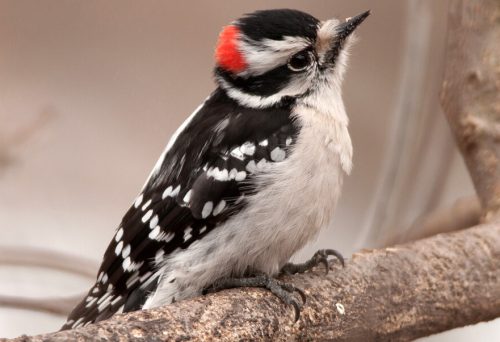
Characteristic |
Range |
|---|---|
Length |
5.5-7 inches |
Weight |
0.7-1 ounce |
Wingspan |
9.8-12 inches |
Relationship to Hairy Woodpecker |
Smaller dimensions, especially in the beak |
Beak |
Short, narrow, and sharp |
Posture |
Straight-backed posture |
Habitat |
North Carolina, year-round, more common in winter |
Behavior |
Often seen in mixed flocks with chickadees and nuthatches |
Diet |
Similar to Hairy Woodpecker, includes nuts, mixed seeds, black oil sunflower seeds, bugs, spiders, bees, caterpillars, and other creatures |
Red-bellied Woodpecker
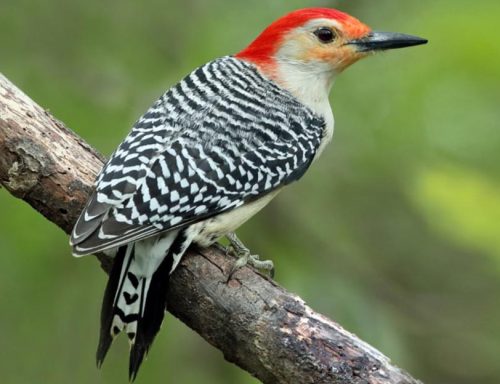
Characteristic |
Range |
|---|---|
Length |
9.4 inches |
Weight |
2.0-3.2 ounces |
Wingspan |
13.0-16.5 inches |
Belly Color |
Pale red |
Nape Color |
Red |
Crest Color (Males) |
Red |
Habitat |
North Carolina, forests, dead trees |
Nesting Behavior |
Lay eggs on a bed of wood chips |
Vocalization |
Loud, rolling call |
Diet |
Suet cakes, nuts, sunflower seeds, similar to Downy and Hairy Woodpeckers |
Red-headed Woodpecker
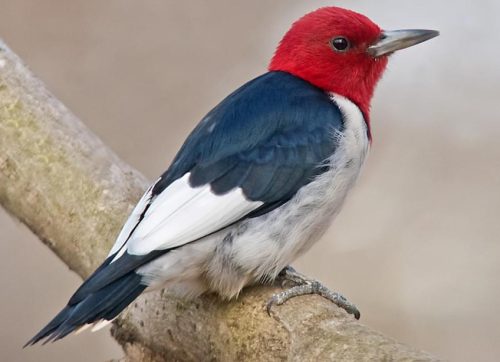
Characteristic |
Range |
|---|---|
Length |
7.5-9.1 inches |
Weight |
2.0-3.2 ounces |
Wingspan |
16.5 inches |
Head Color |
Bright red |
Wing Color |
Half black, half white |
Chest Color |
Snow-white |
Vocalization |
Shrill call |
Habitat |
Year-round, birdfeeders in winter |
Diet |
Suet, nuts, fruits, insects |
Unique Hunting Tactics |
Catching insects in mid-air, hunting on the ground |
Territorial Behavior |
Destructive towards other birds’ eggs in their territory |
Conservation Status |
Declining due to habitat loss over the past 60 years |
Pileated Woodpecker
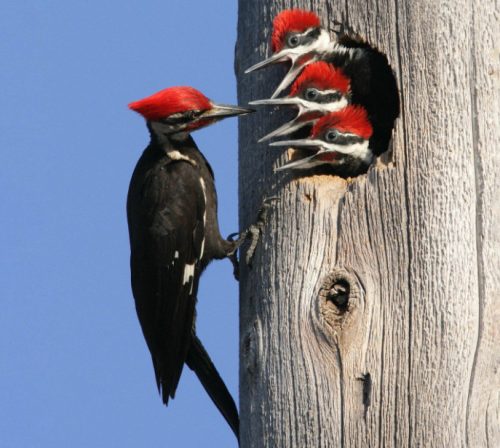
Characteristic |
Range |
|---|---|
Length |
15.8-19.3 inches |
Weight |
8.8-12.3 ounces |
Wingspan |
26.0-29.5 inches |
Crest Color |
Striking red mohawk |
Neck Color |
Mostly black with a striking white strip on either side |
Male Beak Stripe |
Red stripe alongside the beak, resembling a mustache |
Underwing Color |
Broad, white underwings when in flight |
Habitat |
Year-round in North Carolina, drowned and mature forests |
Drumming |
Steady drumming and loud whinnying |
Diet |
Suet, nuts, seeds, similar to other woodpeckers |
Yellow-bellied Sapsucker
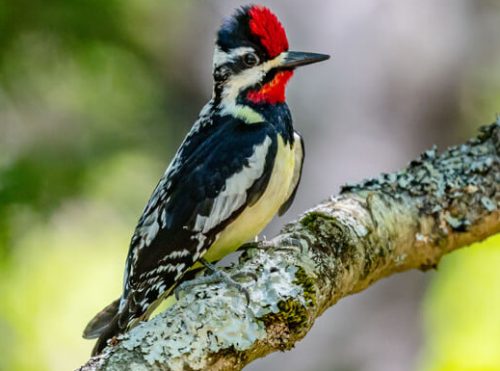
Characteristic |
Range |
|---|---|
Length |
7.1-8.7 inches |
Weight |
1.5-1.9 ounces |
Wingspan |
13.4-15.8 inches |
Belly Color |
Pale yellow |
Forehead Color |
Red |
Male Throat Color |
Red |
Body and Wings |
White and black, with a long streak of white running down both wings |
Habitat |
Visits during winter, nests at an elevation around 6,500 feet high |
Diet |
Primarily sap, creates sap wells in tree bark to consume sap and catch bugs |
Attraction to Yard |
Possible with suet cakes, attracted to young birch and maple trees |
Vocalization |
Staccato drumming, loud calls |
Red-cockaded Woodpecker

Characteristic |
Range |
|---|---|
Length |
7.9-9.1 inches |
Weight |
1.5-1.8 ounces |
Wingspan |
14.2 inches |
Cheek Streak Color |
Red (males only) |
Cheek Streak Visibility |
Can be hard to see among white feathers and black crest |
Body Markings |
Horizontal black and white stripes, faded on stomach, contrasting on back |
Preferred Trees |
Those with red heart fungus, which makes the wood easier to shape |
Nesting Behavior |
Excavate large caverns in trees, poke holes to leak pitch for protection |
Diet |
Berries, but primarily insects from trees with red heart fungus |
Conservation Status |
Endangered species, limited in numbers |
Northern Flicker
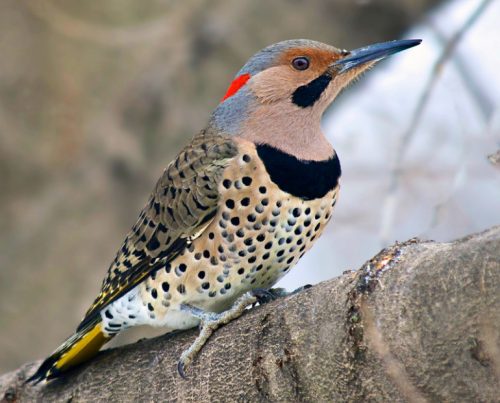
Characteristic |
Range |
|---|---|
Length |
11.0-12.2 inches |
Weight |
3.9-5.6 ounces |
Wingspan |
16.5-20.1 inches |
Body Color |
Mostly brown, decorated with black dots, crescents, and bars |
Neck Color |
Greyish-brown |
Tail and Wing Underside Color |
Yellow |
Male Markings |
Black “mustache” and red nape |
Habitat |
Open expanses, especially near mountains, stays in North Carolina year-round, more common in winter |
Foraging Behavior |
Spends time on the ground looking for insects with slightly curved beaks |
Attraction to Yard |
More attracted to bird baths than bird feeders, nesting pairs can be attracted with a nest box |
Protection |
Setting up guards recommended to keep predators away |
Ivory-billed Woodpecker
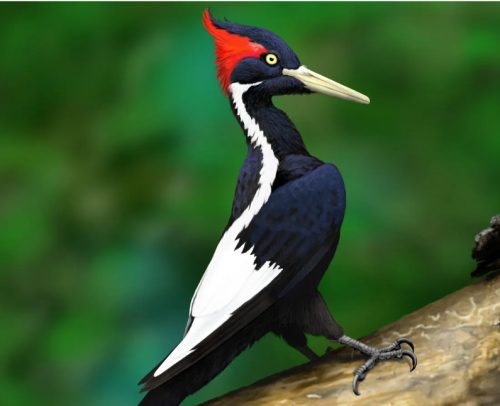
Characteristic |
Range |
|---|---|
Length |
18.1-21.1 inches |
Weight |
15.1-20.1 ounces |
Wingspan |
29.5-31.5 inches |
Habitat |
Originally across the southeastern United States, now very rare |
Last Sighting |
2004 in eastern Arkansas |
Current Status |
Unseen since 2004, the search continues |
Physical Features |
Huge for a woodpecker, longer neck, short crest, straight pale-ivory beak |
Crest Color (Males) |
Red |
Crest Color (Females) |
White |
Body Color |
Mostly white, two strips of white down the back |
Foraging Behavior |
Stripping trees of bark to find large beetle larvae |
Acorn Woodpecker
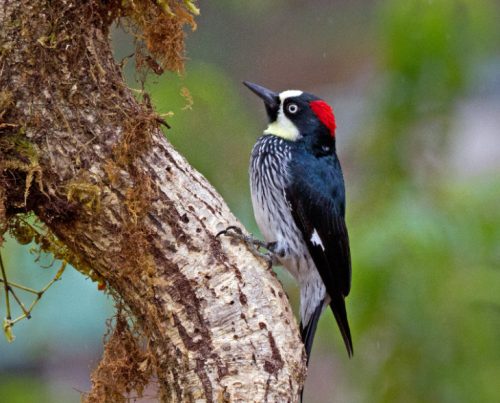
Characteristic |
Range |
|---|---|
Length |
7.5-9.1 inches |
Weight |
2.3-3.2 ounces |
Wingspan |
13.8-16.9 inches |
Crest Color (Males) |
Bright red |
Face Color |
Cream-white with a small circle of black around their beaks |
In-flight Features |
Three spots of white – one on each wing and on their rump |
Crest Color (Females) |
Duller shade of red |
Diet |
Primarily acorns, also hunt for bugs |
Habitat |
Trunks of trees or telephone poles, not native to North Carolina but observed at the Audubon society branch in Durham |
Threats |
Urbanization, which reduces potential living spaces and creates smaller groups |
Conservation Efforts |
Organizations like the Audubon society work to ensure their safety in changing environments |
Conclusion
In summary, these are the various bird species you can encounter in North Carolina. While some are more elusive and haven’t been seen for quite some time, the majority of these feathered inhabitants are a year-round presence, easily observed in your own backyard with the right incentives. North Carolina’s woodpeckers stand as a testament to the importance of preserving biodiversity and cherishing the natural wonders that grace our landscapes.
People Who Read This Also Read:

